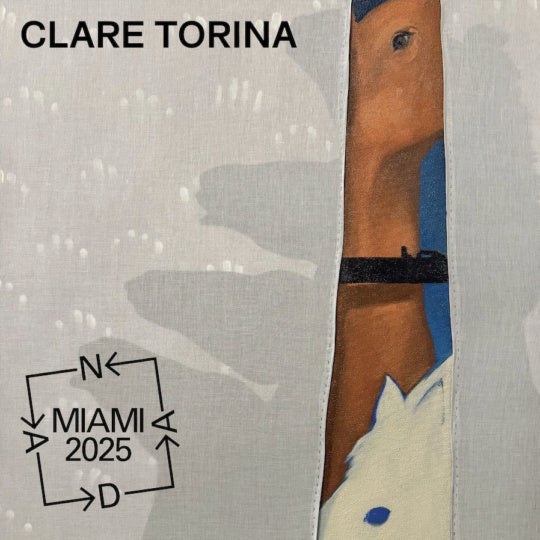
Between the sea and the sky is where the gods do their best work—righting wrongs, facilitating love matches, and even healing the sick. It is in the healing that Austrian-born artist Susanne Wenger (1915 – 2009) connected with the Yoruba gods in Nigeria, and the connection was so deep that she became a high priestess in the Obatala Society. Wenger was already an artist before she moved to Nigeria, with most of her work being surrealist landscapes, but when she started to learn Yoruba myths, she felt compelled to illustrate them, a common practice in shrines across the region. These illustrations of her interpretations of the Yoruba stories are the basis of the screen prints in “Between the Sweet Water and the Swarm of Bees: Works by Susanne Wenger,” on display at Emory University’s Michael C. Carlos Museum of Art through May 15.
The exhibition features 10 works by the late artist (1915 – 2009), given to the museum by Graham and Maryagnes Kerr, who purchased them from the artist at her home in Osogbo, Nigeria in 1965. There are also four poems from Emory’s Rose Manuscript, Archives, and Rare Book Library, three of which were translated by her husband Ulli Beier, displayed next to some of the screen prints. Wenger moved to Nigeria with her husband when he took a professorship at the University of Ibadam in December 1950, and six months after her arrival she contracted tuberculosis. She attributed her recovery one year later to the god of creation, Obàtálá, and became a priestess in the Obàtálá Society, which is where she discovered the fertility goddess Osun. The Osun River runs through southwestern Nigeria and, is commonly referred to as the “sweet water,” hence the exhibition title.

Themes of fertility and creation are prevalent in Wenger’s works, such as a screen print that depicts a black female figure surrounded by six black angels, her elongated breasts hanging over an ailing man as she tries to feed him. A larger male figure lying next to her looks toward the stars while holding an unhatched egg. The poem hanging next to it is titled “Abiku,” which is a term referring to children who die before they reach puberty, and its lines read: “For her body is tired / Tired her milk going sour / where many more mouths gladden the heart.” Wenger’s interpretation of the gods is not as literal as something like the “Birth of Venus,” but is far more dramatic and abstract, emphasizing woman’s role not only as giver of life, but as sustainer of life.
Another print has an olive green background, and shows a woman carrying a man on her back. She holds a partially hatched egg with two heads coming out of it. The eyes in Wenger’s work are never round or centered; they are usually pentagon shaped with the eyeballs on the sides, but always looking up. The figures are never depicted as standing; they are always on their knees, sitting, flying, riding or lying down. There are two lilac, black, and white snakes with intricate geometric shapes drawn inside of them woven between the male and female figures. The snakes are joined at the mouth and tail, forming what resembles an infinity symbol, and in Yoruba mythology two snakes represent fertility, renewal and regeneration.

Many Nigerian cities have shrines to Yoruba deities, including the city of Osogbo where Wenger lived. Wenger used her talents as an artist to help restore the shrine to Osun at Ojubo Osogbo temple, which had been damaged by termites. She fully immersed herself in the regional culture as a white high priestess and artist in a black society created for and by black people, which raises some pertinent questions: Would a white woman be able to create this work and be widely accepted today? In 2016, with think pieces on Huffington Post, Salon, Reddit and dozens of other sites littering the Internet about who has the right to voice whose story, what would they say about Wenger? Many photos of Wenger show her wearing dresses made from Ankara fabric and outfits made with kente cloth. Where is the line between inspiration and cultural appropriation? Where does cultural assimilation turn into caricature? Would the fact that she helped the region become an artistic hub and restored the sacred shrines be taken into account? Would it matter?

In a part of the world where being black is as common as breathing, her whiteness never seems to have been a threat to the religion. The power dynamic of white privilege may have played a role in her success as an artist to the outside world, but it did not have a place in her religious beliefs. Today, with Yoruba being one of the continent’s largest religions, hundreds of thousands of people travel to the temple that holds the Osun shrine that Wenger restored. They come every summer to bathe in the Osun River to worship and celebrate the goddess.
Kelundra Smith is a freelance arts journalist and editor. Her work has been published in the Atlanta Journal Constitution, Atlanta magazine,Charleston Post & Courier, American Theatre Magazine, Dramaticsmagazine, Syracuse New Times, and on BroadwayWorld.com andArtsATL.com. She has also done marketing and public relations consulting for nonprofit arts organizations, including Syracuse Stage, Alliance Theatre, Rialto Center for the Arts and Horizon Theatre Company. Follow her on Twitter @pieceofkay for musings on art, media, television, and everything else.




